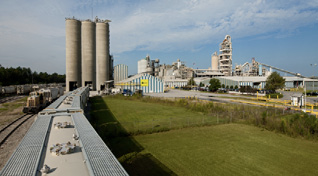Sustainability-Linked Finance Is One Of The Fastest Growing Sectors In The Finance Space. It’s Also Helping Change The Cement Industry.
By Jonathan Rowland

The cement industry talks a lot about sustainability. Major cement companies all have some sort of sustainability strategy. Sustainability is also a central component to the work of the two global cement associations, the GCCA and WCA, and the various regional associations.
The Portland Cement Association (PCA) for example, proudly states on its website that “America’s cement manufacturers are committed to sustainably producing the highest quality product,” while the association itself is developing a roadmap to help its members achieve carbon neutrality across the concrete value chain by 2050.
A few cement companies are now starting to go further in their ambitions by linking their sustainability goals with their finance strategy via sustainability-linked loans or bonds. Recently, for example, Cementos Argos announced a $300 million loan agreement in which the interest rate is linked to carbon reduction indicators and an increase in the percentage of women in leadership positions, the third credit linked to ESG performance signed by the company this year.
Accountability for Sustainability
Such sustainability-linked finance is a rapidly growing sector in the broader green finance universe, explained Robert White, head of Green & Sustainable Hub Americas at investment bank Natixis, one of the lenders in the Cementos Argos deal.
“Sustainable finance started with green bonds, the proceeds from which are ring-fenced for investment in specific green assets, such as renewable energy,” White began. “The market has since evolved with the development of behaviour-based finance agreements. These move away from earmarking and instead focus on the objectives of the borrower. In this type of agreement, the borrower can use the proceeds as they see fit, but commits to achieving defined sustainability targets.”
There are then rewards and penalties, written into the loan or bond wording, for meeting or failing to meet those targets. For loans, the interest rate may rise or fall as a consequence of the company’s performance against the given indicators; for bonds, there is usually a step up in the coupon value, if the company fails to hit the target. “With this approach, you’re taking a step beyond publishing sustainability reports and adding accountability,” continued White. “It gives some teeth to a company’s commitments.”
Or as Cementos Argos’ Legal and Sustainability Vice President Maria Isabel Echeverri more optimistically put it, “In addition to ratifying the confidence of financial entities in the company’s sustainability strategy, [the loan] allows us to extend the duration of the debt and improve its financial cost, which has a positive impact on Argos’ debt indicators.”

A Growing Trend
Votorantim Cimentos set the trend for sustainability-linked finance in the cement industry, issuing one of the first sustainability-linked loans in 2019, with Natixis again involved. The $290 million loan agreement included KPIs related to alternative fuel usage, clinker-to-cement ratio, and net CO2 per tonne of cement.
CEMEX followed suit in October 2020, announcing an amended loan agreement with several financial institutions, amounting to $3.2 billion and incorporating five sustainability-linked metrics. The Mexico-based company then released a Sustainability-Linked Financing Framework this year, outlining its approach for issuing new sustainability-linked finance agreements. This framework includes three KPIs: net CO2 per tonne of cement, clean electricity consumption and alternative fuels rate.
In Europe, Holcim has been among the early trendsetters, releasing its Sustainability-Linked Financing Framework in late 2020. A sustainability-linked bond offering followed, again tied to net CO2 per tonne of cement.
The growing number of companies taking up sustainability-linked financing in the cement sector is a “real game-changer,” said White. “By linking the finance strategy with the sustainability strategy, it provides more certainty around sustainability, for the life of the finance agreement, whatever happens in the C-suite.”
It also brings the worlds of sustainability and finance into direct contact: worlds that may not have mixed before in the corporate setting. As a simple example, in the press release announcing the CEMEX framework, it is the company’s CFO that is quoted. “Climate change is one of the biggest challenges of our time,” Maher Al-Haffer said. “We will continue to address it as a fundamental component of our business strategy.”
Sustainability-linked finance is also itself evolving to ensure the targets included in any agreement are in line with wider sustainability aims. As part of a recent update to the Sustainability-Linked Loan Principles from the three global loan market associations, the LSTA, LMA and APLMA, the metrics to be monitored and reported are now subject to external verification. Moreover, external organizations, such as the Science-based Targets Initiative, are also often called in to verify the calibration of targets is in line with global goals, e.g., under the Paris Agreement.

Not Just About CO2
Although much of the focus has been carbon emissions, other sustainability-linked metrics can be linked with financing, as Cementos Argos has demonstrated by including a gender balance target.
“When it comes to cement and other heavy industries, you have to have a carbon metric. You’re not credible if you don’t,” said White, who worked with Colombian cement company on its loan. “When you’ve covered that, you can absolutely consider other indicators. Cementos Argos is a great example, as they have a meaningful commitment to gender balance in their workforce, particularly the number of women in senior leadership positions. We therefore felt that it would be helpful to focus on that. It also makes sense to have a gender diversity target in what is traditionally a male-dominated industry.”
The Additionality Question
There is no doubt that sustainability-linked financing is supportive of companies that already take sustainability seriously: Votorantim Cimentos, Cementos Argos, Cemex and Holcim, all have positioned themselves as leaders in the cement industry’s sustainability transition. But can sustainability-linked financing encourage change elsewhere? White believes so, citing the example of industry leaders as “unlocking and proving the benefits of this type of financing.”
“I have also worked with borrowers’ finance teams who perhaps have not thought much about sustainability before,” White continued. “And I’ve seen it be a force for change within companies. It’s often sparked new conversations and connections within companies, and that’s incredibly powerful.”
“As banks and other financial institutions come under pressure to monitor and measure the sustainability performance of their investments, it also provides another route to capital that would not otherwise be available to companies,” added White. “So, there is now an incentive to choose sustainability, as well as the threat that liquidity might dry up, as financial markets are put under pressure to support the sustainability transition.”
And this really lies at the heart of why companies should consider sustainability-linked finance, according to White: it shows an alignment of corporate sustainability ambitions to growing societal expectations for a green transition.
“In the cement industry, you are under constant pressure to decarbonize – not to mention at risk from future regulatory tightening. Sustainability-linked loans and bonds help you articulate not just to investors and lenders, but to shareholders, governments, regulatory agencies and the wider public, that you’re genuinely committed to the climate transition. And it demonstrates to all your employees, suppliers and customers that your sustainability strategy is sanctioned at the highest levels of your organization as an integral part of your culture and business strategy,” said White.



